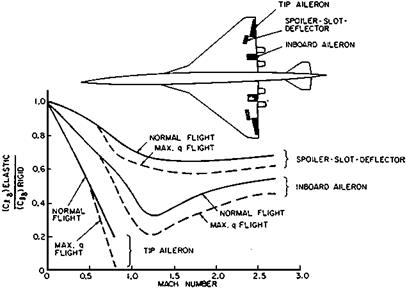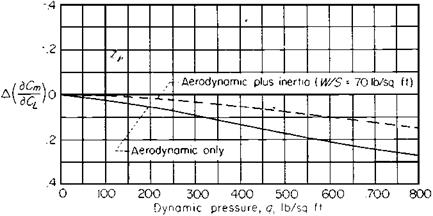Aeroelastic Effects on Static Longitudinal Stability
There had been several published studies of the effects of aeroelasticity on static longitudinal stability, going back to 1942. But the subject really came to wide attention with the appearance of the very advanced, and flexible, Boeing B-47 Stratojet, first flown in 1947. Richard B. Skoog of NACA reported on the details of the stability and control static aeroelastic effects on this airplane (Skoog, 1957) based on classified work done six years earlier.
Strangely, while some individual effects are large, Skoog found that the overall aeroelastic modification to longitudinal stability and control is small (Figure 19.6). Wing symmetric bending causesthe wing tipsto wash out at increasing anglesof attack. Thismovesthe airload
|
Figure 19.3 Arrangement of ailerons, spoilers, and flaps on the Boeing 707 airplane. The outboard and inboard flap-type ailerons are manually controlled, with the help of internal aerodynamic balance and balancing or geared tabs (here called servo tabs). The spoilers are of the slot-lip variety, located just ahead of the flaps. (From Cook, The Road to the 707, 1991) |
relatively inboard, resulting in a forward, or destabilizing, shift of the wing aerodynamic center. However, there is a net loss in lift at positive angles of attack, a reduction in the lift curve slope. This is stabilizing, increasing the relative effect of the tail lift.
Fuselage bending under tail aerodynamic loads is destabilizing. That is, for upward tail loads, the fuselage bends upward at the rear, decreasing the tail angle of attack and the restoring moment of the tail. However, this effect is largely canceled by the downward bending of the aft fuselage under its own weight and the weight of the tail assembly, at the lower airspeeds associated with higher angles of attack. Just as wing torsion leads to aileron reversal at a sufficiently high airspeed, so does vertical bending of the aft fuselage lead to elevator or longitudinal control reversal. In the case of elevator controls, stabilizer twist adds to the problem (Collar and Grinsted, 1942).
The basic static aeroelastic analysis methods used up to the time when finite-element methods were introduced was the method of influence coefficients. Early expositions of the
|
Figure 19.4 Two airplanes with slot-lip spoiler lateral controls to minimize loss in control power at high airspeeds due to wing twist: the McDonnell-Douglas DC-10 (above) and the Lockheed 1011 (below). In each case small outboard flap-type ailerons are used only at low airspeeds. (From NASA TN D 8373 and TN D 8360, 1977) |
|
Figure 19.5 Effects ofMach number and dynamic pressure (q) on the effectiveness of three alternate aileron designs for the Boeing 2707 SST. The spoiler-slot-deflector is effective at all airspeeds, while the tip aileron reverses in effectiveness around a Mach number of 1.0. (From Perkins, Jour. of Aircraft, July-Aug. 1970) |
|
Figure 19.6 The overall effect of flexibility on static longitudinal stability ofthe Boeing B-47 airplane. The net effect is moderate, a forward neutral point shift of only 7 percent at a dynamic pressure of 500 pounds per square foot. (From Skoog, NACA Rept. 1298, 1957) |
influence coefficient method were given in Pai and Sears (1949) and in a classified NACA Research Memorandum of 1950, written by Richard Skoog and Harvey H. Brown.
As early as 1954 an important relationship was stated between frequency response and static aeroelastic characteristics. If aeroelasticity were a branch of pure mathematics, this relationship would be stated as a theorem, in these terms:
Airplane frequency response at frequencies below the lowest structural bending or torsional modes should agree with calculated rigid-body transfer functions when quasi-static aeroelastic effects are included.
This relationship, proved experimentally with the Boeing B-47 (Cole, Brown, and Holleman, 1957), provides an important check on static aeroelastic methods. In the 1980s, this relationship provided the basis for a comparison of alternate quasi-static aeroelastic methods for the Northrop B-2 Stealth Bomber.















